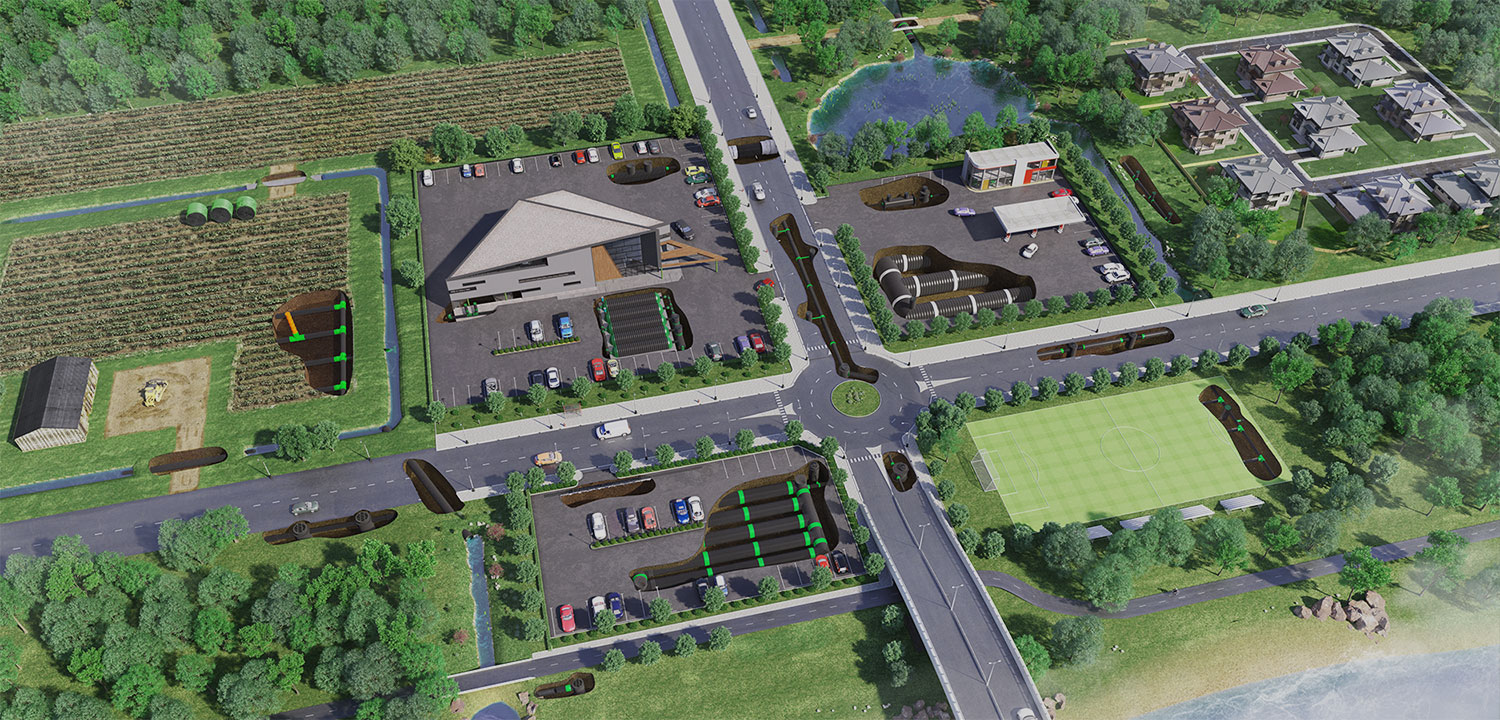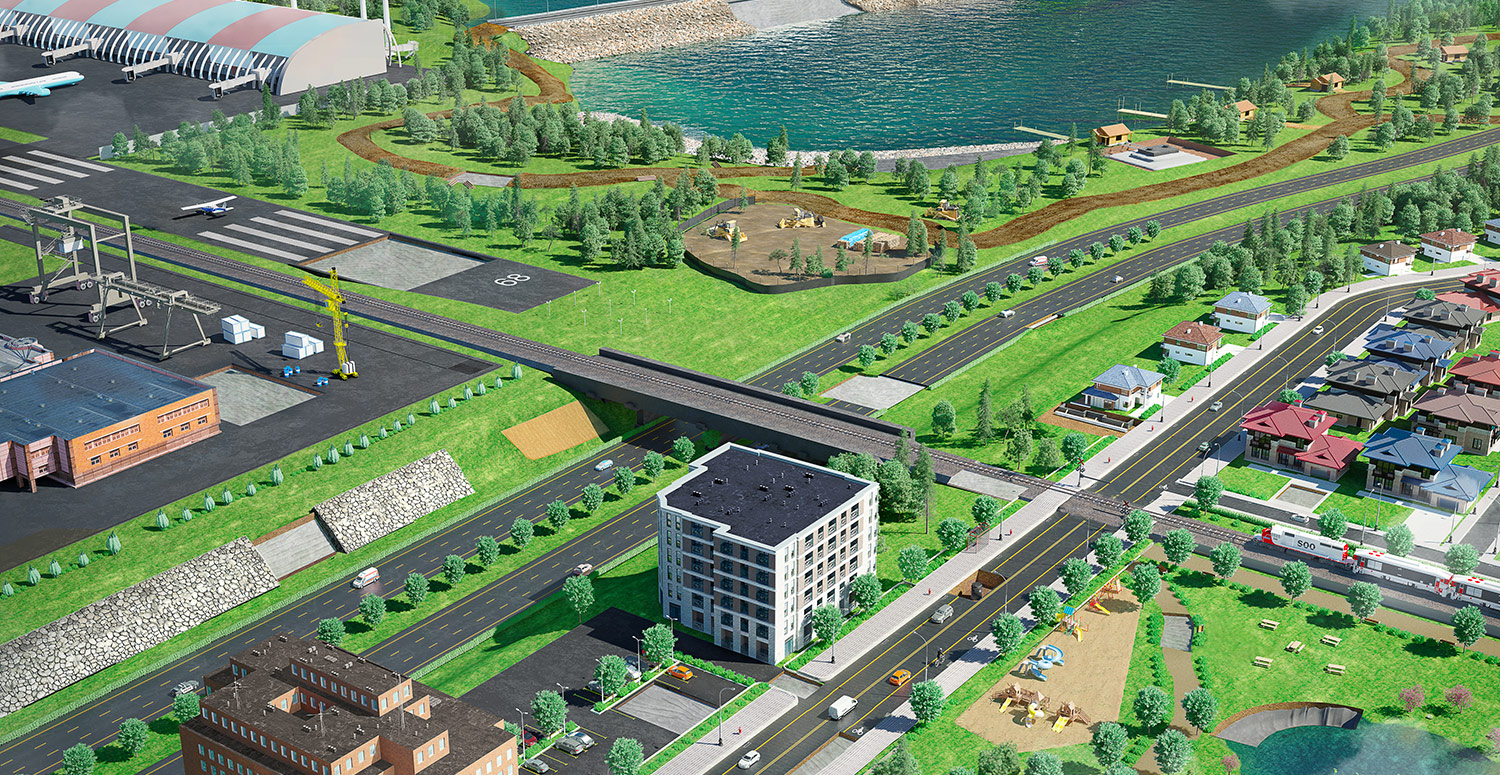
-
+
Agricultural subsurface drainage
Promotes gravitational drainage of water in agricultural land after precipitation and helps control the ground water level.
-
+
Foundation and basement drainage
Subsurface collection at a building's foundation footings to collect surplus water from the soil. The water collected is disposed of either by gravity or by pumping to a storm water sewer, an exfiltration basin or other outlets.
-
+
Linear collection
Perpendicular collection across the full width of a drainage surface such as a parking deck, street or sloped residential driveway. Excavation area and depth are less than for conventional drainage systems.
-
+
Others applications of Collecting
For controlling the water level in an open-air retention basin, lake or pond. Custom manufactured based on the hydrological conditions and water levels to master.
-
+
Percolation well
Percolation wells are used to collect and reintroduce surface water into the ground through exfiltration.
-
+
Road and Highway drainage
Helps to lower the ground water level or to drain infiltration water into a ditch, culvert or storm water sewer.
-
+
Surface collection
Intercepts and channels storm water to appropriate conveyance pipes.
-
+
Trench drain
For collecting surface water runoff and evacuating it to an outlet or reintroducing it into the soil via exfiltration.
-
+
Turf and recreation drainage
For collecting infiltrated surface runoff or lowering the ground water level, then evacuating the water to an outlet (a ditch, peripheral collector, storm water sewer) or to a permanent storage reservoir for reuse.
-
+
Arch culverts made of polymer
An engineered structure in a water course intended to allow crossing while ensuring the free flow of water and unrestricted movement of aquatic fauna. Mainly used in rural, forestry and mining sectors, they allow the crossing without affecting the banks and stream bed and without disturbing the flora and fauna of an ecosystem.
-
+
Collector and drainage outlet
A collector is an underground pipe that collects water from several drainage lines to divert it towards a drainage outlet.
-
+
Culvert lining
Renewal of a culvert with defects or nearing the end of its service life, by inserting an HDPE pipe with smooth interior and exterior walls.
-
+
Ditch piping
Water pipe network for storm water and non-roadway surface runoff that can lower or replenish ground water by infiltration and exfiltration or direct it towards an outlet.
-
+
Driveway culvert
Engineered structure in a ditch to allow crossing between a public roadway and adjacent land while ensuring the free flow of water.
-
+
HDPE culverts
An engineered structure in a water course intended to allow crossing while ensuring the free flow of water and unrestricted movement of aquatic fauna. HDPE pipes are mostly used for roadway infrastructure.
-
+
Other application of Conveying
Custom structure that can be used as a ventilation pipes aerial and subsurface, as a pumping station or as a beaver barrier.
-
+
Steel culvert
An engineered structure in a water course intended to allow crossing while ensuring the free flow of water and unrestricted movement of aquatic fauna. Steel pipes are mainly used in rural, forestry and mining sectors.
-
+
Storm water sewer
Water pipe network distinct from sanitary sewers, specifically for conveying storm water, surface runoff and snow melt.
-
+
Detention system
Subsurface storage zone allowing quantity control of surface runoff before it is evacuated to an outlet. Water volume can be evacuated with or without flow control.
-
+
Flow control and regulation
Vortex device to control the flow and velocity of water.
-
+
High-volume storage
Permanent subsurface reservoir serving as a water supply.
-
+
Other applications of Storage
Subsurface storm water reservoir for domestic or exterior garden use.
-
+
Retention system
Based on the percolation properties of the soil, a subsurface storage zone that allows previously collected and treated surface runoff to be returned to the ground water to reproduce hydrological conditions that existed prior to urbanization.
-
+
Control of sediments and floating debris
Structure that helps maximize removal of sediments and floating debris from surface runoff at the source to prevent it from dispersing through the whole network.
-
+
Control of TSS, nutrients, heavy metals and hydrocarbons using filtration
System that maximizes the removal of total suspended solids (TSS), nutrients, heavy metals and hydrocarbons from surface runoff before they are conveyed to an outlet.
-
+
Control of TSS, oils and floating debris using hydrodynamic separation
This system maximizes removal of total suspended solids (TSS), hydrocarbons and floating debris from surface runoff before they are conveyed to an outlet.
-
+
Control of TSS, oils and floating debris using settling and separation
System that helps remove total suspended solids (TSS), oils and floating debris from surface runoff before they are conveyed to an outlet.

-
+
Basin
A geotextile used for separating the natural soil from granular materials placed at the bottom and on slopes of a non-watertight basin. A geotextile provides protection against geomembrane puncture in watertight basin applications.
-
+
Slab and building foundation
A filtration geotextile to protect the building foundation drainage system, a geocomposite for draining water from the surface of structures, and a geotextile to improve the cure of poured concrete are used during construction of slab and building foundation.
-
+
Bank protection
Nonwoven geotextile placed underneath the river banks’ riprap, in streams or open water, to prevent the erosion of the natural ground.
-
+
Dam and dikes
Geotextile installed under the installed riprap in the construction of dams and dikes.
-
+
Sediment retention
Specialized geotextile for the control and limitation of sediment silting at construction sites, in streams or lakes.
-
+
Drainage trench
A geotextile enclosing draining granular materials, used to filter fine particles and separate different particle size materials.
-
+
Grow vegetation areas
Geosynthetic materials for erosion control and protection of seeding in berms. Anti-root and anti-vegetative ground cover used to stop the growth of weeds.
-
+
Residential parking area
Geotextiles are used in residential parking areas to improve the mechanical behaviour of the foundation’s granular materials.
-
+
Retaining walls, embankments and berms
Geosynthetic materials with varied properties that can be used for preservation of the drainage properties of granular materials, or for erosion control purposes in berms and internal reinforcement for embankments and retaining walls.
-
+
Septic fields
Geotextile that facilitates evapotranspiration and oxygen transfer in septic fields applications.
-
+
Winter protection
Nonwoven geotextile used for winter protection of trees, shrubs and lawn.
-
+
Airport runways
Geotextiles and geogrids are used in airport runways to preserve and increase the efficiency of granular materials from a mechanical and hydraulic point of view.
-
+
Catch basins and concrete manholes protection
The geocomposite installed around the perimeter of a manhole or a catch basin increases the structure’s lifespan.
-
+
Commercial parking areas
Geotextiles and geogrids are used in commercial parking areas to improve the mechanical behaviour of the foundation’s granular materials.
-
+
Permanent private roadway
Geotextiles and geogrids are used in permanent private roadways to improve the structural behaviour of the foundation’s granular materials.
-
+
Permanent public roadway
Geotextiles and geogrids are used in permanent public roadways to preserve and increase the efficiency of granular materials from a mechanical and hydraulic point of view.
-
+
Public access road
Geotextiles and geogrids are used in public access roads, such as municipal parks and access roads for emergency vehicles, to improve the mechanical behaviour of the foundation’s granular materials.
-
+
Railway tracks
Geotextiles and geogrids are used to improve the structural behaviour underneath railways.
-
+
Roadway widening
Geotextiles and geogrids are used in roadway widening works to preserve and increase the efficiency of granular materials from a mechanical and hydraulic point of view.
-
+
Storage and loading areas
Geotextiles and geogrids are used in storage and loading areas to improve the mechanical behaviour of the foundation’s granular materials.
-
+
Temporary roadway
Geotextiles and geogrids are used in temporary roadways to improve the structural behaviour of the in situ foundation’s materials.
Sectors
The undisputed leader in Eastern Canada and the Northeastern United States, Soleno serves four major sectors.
Experts




